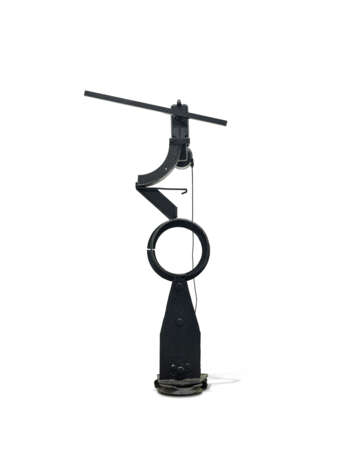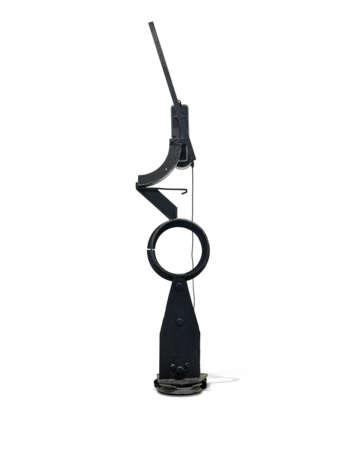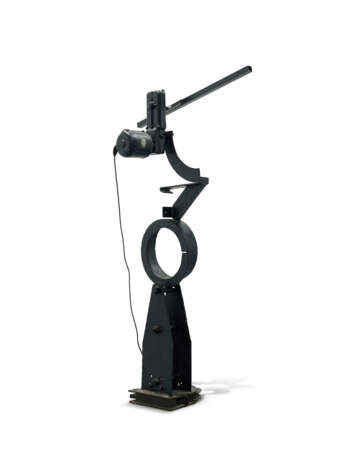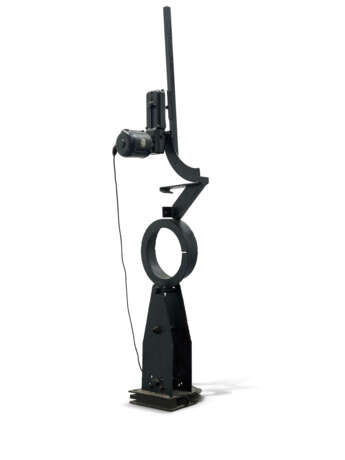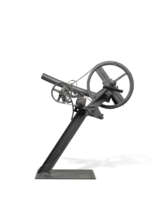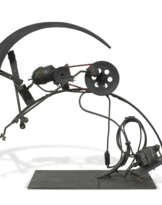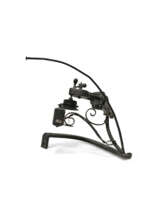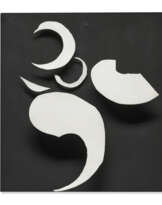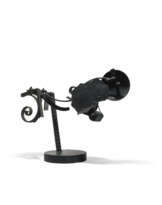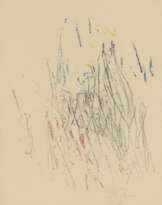ID 813954
Los 9 | Jean Tinguely (1925-1991)
Schätzwert
€ 60 000 – 90 000
Isidor
fer, acier, bois et moteur électrique
230 x 102 x 55 cm.
Réalisée en 1965, cette œuvre est unique.
iron, steel, wood and eletric motor
90 1/2 x 41 3/4 x 21 5/8 in.
Executed in 1965, this work is unique.
Provenance
Galerie Iolas, Paris
Collection Monsieur et Madame Wossermann, Boston
Galerie Beaubourg, Paris
Acquis auprès de celle-ci en 2000
Literature
K.G.P. Hultén, Méta, Boston, 1972 (illustré).
C. Bischofberger, Jean Tinguely - Catalogue raisonné Sculptures and Reliefs 1954-1968, Zurich, 1982, No. 367 (illustré p. 248).
in Vie des Arts, mardi 19 août 1997.
Exhibited
New-York, The Jewish Museum (novembre-janvier); Washington D.C., The Washington Gallery of Modern Art (janvier-février); Minneapolis, The Walker Art Center (mars-avril); Pittsburgh, The Carnegie Institute (avril-mai); Seattle, The Contemporary Art Council (juin-juillet), Two Kinetic Sculptors, Nicolas Schöffer - Jean Tinguely, 1966. No. 74.
Paris, Forum des Halles, Paris, Patrie des Peintres, juin-juillet 1978 (illustré au catalogue d'exposition p. 87).
Vence, France, Galerie Beaubourg - Château Notre-Dame-des-Fleurs, Pour la galerie, décembre 1995-mars 1996.
Special notice
Artist's Resale Right ("droit de Suite").
If the Artist's Resale Right Regulations 2006 apply to this lot, the buyer also agrees to pay us an amount equal to the resale royalty provided for in those Regulations, and we undertake to the buyer to pay such amount to the artist's collection agent.
This item will be transferred to an offsite warehouse after the sale. Please refer to department for information about storage charges and collection
details.
Post lot text
« Parce que je veux trouver la continuité, il m'arrive souvent de faire des dessins après avoir fait une sculpture. J'essaie d'envisager ses variations possibles; en vue d'une nouvelle version, pour essayer d'en tirer profit au maximum. Et pour penser, rêver ». - Jean Tinguely
“Because I want to find continuity, I often make drawings after making a sculpture. I try to consider its possible variations; in view of a new version, to try to make the most of it. And to think, to dream.” - Jean Tinguely
À l’instar d’Alexander Calder et quoique par des formes plastiques tout à fait différentes, le travail de Jean Tinguely s’intéresse à une question centrale dans les années d’après-guerre et à l’ère du progrès industriel – celle du mouvement dans la sculpture. Comment passer de la tridimensionnalité statique à la tridimensionnalité animée ? Marquée par l’influence des ready-made de Marcel Duchamp ainsi que par le développement exponentiel des machines et objets manufacturés au cours des Trente Glorieuses, l’œuvre de l’artiste suisse prend la forme d’assemblages – parfois volontiers anthropomorphes – dont la motorisation permet la mise en branle. Ne se contentant pas de déployer dans l’espace leurs formes singulières et dégingandées, ces objets d’un genre inédit bruissent des sons inhérents à leur mouvement : ronronnements du moteur, frottements des différentes parties entre elles, grincement d’articulations inhabituées à fonctionner de concert.
Le titre de l’œuvre présente dans la collection du Comte et de la Comtesse Jean-Jacques de Flers interroge. Isidor est-il une référence à Isidore Ducasse, Comte de Lautréamont, dont la définition de la beauté (« Beau comme la rencontre fortuite sur une table de dissection d'une machine à coudre et d'un parapluie ») dans les Chants de Maldoror sera citée par Breton, Aragon et Soupault comme l’une des premières incursions dans le monde du Surréalisme ? Il s’avère que l’œuvre de Jean Tinguely fonctionne par essence comme la juxtaposition improvisée d’éléments disparates, n’ayant a priori aucune raison de se trouver confrontés les uns avec les autres. Peut-être s’agit-il aussi d’un clin d’œil à l’œuvre de Man Ray, L’énigme d’Isidore Ducasse (1920). L’artiste a en effet souvent joué de citations dans les titres de ses œuvres (Totem II faisant référence au Totem de Max Ernest au Totem I de Jackson Pollock, Dylaby empruntant son titre à celui d’un combine-painting de Robert Rauschenberg, ou encore La roue évoquant La roue de bicyclette de Marcel Duchamp).
Par l’utilisation d’objets du quotidien dans ses œuvres, Jean Tinguely s’inscrit dans les préoccupations du mouvement des Nouveaux Réalistes, dont il est l’un des membres fondateurs. Comme Arman, César et les autres membres du groupe, il aura cherché tout au long de sa trajectoire artistique à se réapproprier le réel, rompant ainsi avec les courants abstraits majoritaires de l’immédiate après-guerre (abstraction lyrique en France, expressionnisme abstrait aux Etats-Unis). Avec humour et irrévérence, Isidor participe ainsi pleinement à ce « recyclage poétique du réel urbain, industriel, publicitaire » évoqué par le théoricien du groupe, Pierre Restany (60/90. Trente ans de Nouveau Réalisme, Paris, 1990, p. 76).
Like Alexander Calder, Jean Tinguely's work addresses the question of movement in sculpture, which was central to the post-war era of industrial progress. How do we move from static three-dimensionality to animated three-dimensionality? Influenced by Marcel Duchamp's ready-mades as well as by the exponential development of machines and manufactured objects during the Thirty Glorious Years, the Swiss artist's work takes the form of assemblages— sometimes readily anthropomorphic —whose motorization allows them to be set in motion. Not content with simply displaying their singular, gangly forms in space, these novel objects rustle with the sounds inherent to their movement: the whirring of an engine, the rubbing of the various parts together, the creaking of joints that are not used to working in symbiosis.
The title of the work in the collection of the Count and Countess Jean-Jacques de Flers raises questions. Is Isidor a reference to Isidore Ducasse, Count of Lautréamont, whose definition of beauty (“Beautiful as the chance meeting on a dissection table of a sewing machine and an umbrella”) in the Songs of Maldoror was cited by Breton, Aragon and Soupault as one of the first forays into the world of Surrealism? It turns out that Jean Tinguely's work functions in essence as an improvised juxtaposition of disparate elements that have no prior reason to be confronted with each other. Perhaps this is also a reference to Man Ray's L'énigme d'Isidore Ducasse (1920). The artist has often used quotations in the titles of his works (Totem II referring to Max Ernest's Totem to Jackson Pollock's Totem I, Dylaby borrowing its title from that of a combine-painting by Robert Rauschenberg, or La roue evoking Marcel Duchamp's La roue de bicyclette).
By using everyday objects in his work, Jean Tinguely was in line with the concerns of the New Realists, of which he was a founding member. Like Arman, César and the other participants of the group, he sought throughout his artistic career to reappropriate reality, thus breaking away from the majority abstract movements of the immediate post-war period (lyrical abstraction in France, abstract expressionism in the United States). With humour and irreverence, Isidor thus participated fully in the “poetic recycling of urban, industrial and advertising reality” evoked by the group's theorist, Pierre Restany (60/90. Thirty Years of New Realism, Paris, 1990, p. 76).
| Künstler: | Jean Tinguely (1925 - 1991) |
|---|---|
| Kunst Stil: | Nachkriegskunst |
| Herkunftsort: | Westeuropa, Europa, Schweiz |
| Künstler: | Jean Tinguely (1925 - 1991) |
|---|---|
| Kunst Stil: | Nachkriegskunst |
| Herkunftsort: | Westeuropa, Europa, Schweiz |
| Adresse der Versteigerung |
CHRISTIE'S 9 Avenue Matignon 75008 Paris Frankreich | ||||||||||||||
|---|---|---|---|---|---|---|---|---|---|---|---|---|---|---|---|
| Vorschau |
| ||||||||||||||
| Telefon | +33 (0)1 40 76 85 85 | ||||||||||||||
| Fax | +33 (0)1 40 76 85 86 | ||||||||||||||
| Nutzungsbedingungen | Nutzungsbedingungen | ||||||||||||||
| Versand |
Postdienst Kurierdienst Selbstabholung | ||||||||||||||
| Zahlungsarten |
Banküberweisung | ||||||||||||||
| Geschäftszeiten | Geschäftszeiten
|
